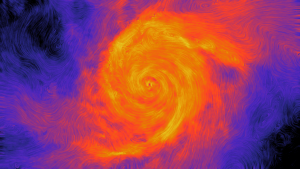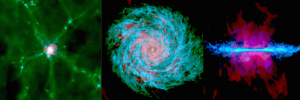“Auriga” project helps uncover the history of galaxies

A research team led by HITS scientist Robert Grand ran 36 simulations of Milky Ways on German supercomputers, for the first time including the magnetic fields that permeate the gas and dust between the stars.
See also the press release of the ‘Royal Astronomical Societ’
Thousands of processors, terabytes of data, and months of computing time have helped a group of researchers in Germany create some of the largest and highest resolution simulations ever made of galaxies like our Milky Way. The work of the Auriga Project, led by Dr. Robert Grand of the Theoretical Astrophysics group at HITS (Heidelberg Institute for Theoretical Studies), now appears in the journal “Monthly Notices of the Royal Astronomical Society”. The results have been achieved in one subproject of the collaborative research center 881, “The Milky Way System”, of the German Research Foundation (DFG).
Astronomers study our own and other galaxies with telescopes and simulations, in an effort to piece together their structure and history. Spiral galaxies like the Milky Way are thought to contain several hundred billion stars, as well as copious amounts of gas and dust.
The spiral shape is commonplace, with a massive black hole at the center, surrounded by a bulge of old stars, and arms winding outwards where relatively young stars like the Sun are found. However, understanding how systems like our Galaxy came into being continues to remain a key question in the history of the cosmos.
The enormous range of scales (for example, stars, the building blocks of galaxies, are each about one trillion times smaller in mass than the galaxy they make up), as well as the complex physics involved, presents a formidable challenge for any computer model. A group of international scientists from HITS (Germany), Durham University (UK), Max Planck Institute for Astronomy (Germany) and Massachusetts Institute of Technology (USA) have tackled this obstacle.
Using the Hornet/Hazel Hen (Stuttgart) and SuperMUC (Garching) supercomputers in Germany, the team ran simulations of 30 different Milky Ways at high resolution, of which 6 were ran at very high resolution for even more details. The simulations ran for several months and used approx. 18 million CPU hours in total. For their simulations the researchers used the “AREPO” code, developed by HITS researcher and group leader Prof. Volker Springel, which enables scientists to simulate a wide range of galaxy shapes and sizes with unique precision and includes one of the most comprehensive physics models to date. The code includes phenomena such as gravity, star formation, hydrodynamics of gas, supernova explosions, and for the first time the magnetic fields that permeate the interstellar medium, more precisely, the gas and dust between the stars. Black holes also grew in the simulation, feeding on the gas around them, and releasing energy into the wider galaxy.
“Astronomers will now be able to use our work to access a wealth of information”

The wide range of physics in the simulations provides valuable insight and predictions for many aspects of galactic astronomy: “The outcome of the Auriga Project is that astronomers will now be able to use our work to access a wealth of information, such as the properties of the satellite galaxies and the very old stars found in the halo that surrounds the galaxy.”, says HITS researcher Robert Grand. “In addition, we are able to follow the growth of magnetic fields and probe how they affect the properties of gas and vice versa.”
The team also sees that smaller galaxies can spiral into the Milky Way galaxy early in its history, in a process that could have created large spiral discs.
Grand adds: “For a spiral galaxy to grow in size, it needs a substantial supply of fresh star-forming gas around its edges – smaller gas-rich galaxies that spiral gently into ours can provide exactly that.”
The scientists will now combine the results of the Auriga Project work with data in surveys from observatories like the Gaia mission, to better understand how mergers and collisions shaped galaxies like our own.
RAS Media Contacts:
Dr. Robert Massey
Royal Astronomical Society
+44 (0)20 7292 3979, cell: +44 (0)7802 877699
rm@ras.org.uk
Dr. Morgan Hollis
Royal Astronomical Society
+44 (0)20 7292 3977
mh@ras.org.uk
HITS Media Contact:
Dr. Peter Saueressig
HITS, Heidelberg Institute for Theoretical Studies
+49 6221 533 245
peter.saueressig@h-its.org
Science Contact:
Dr. Robert Grand
Theoretical Astrophysics group (TAP)
HITS Heidelberg Institute for Theoretical Studies, Germany
+49 6221 533 326, cell: +49 (0)162 771 7156
robert.grand@h-its.org
Reference:
“The Auriga Project: The Properties and Formation Mechanisms of Disc Galaxies Across Cosmic Time,” Robert J. J. Grand et al., 2017 May, Monthly Notices of the Royal Astronomical Society, vol. 467, pp. 179-207 [https://academic.oup.com/mnras/article-lookup/doi/10.1093/mnras/stx071, preprint: https://arxiv.org/abs/1610.01159].
The Royal Astronomical Society
The Royal Astronomical Society (RAS), founded in 1820, encourages and promotes the study of astronomy, solar-system science, geophysics and closely related branches of science. The RAS organizes scientific meetings, publishes international research and review journals, recognizes outstanding achievements by the award of medals and prizes, maintains an extensive library, supports education through grants and outreach activities and represents UK astronomy nationally and internationally. Its more than 4,000 members (Fellows), a third based overseas, include scientific researchers in universities, observatories and laboratories as well as historians of astronomy and others.
The RAS accepts papers for its journals based on the principle of peer review, in which fellow experts on the editorial boards accept the paper as worth considering. The Society issues press releases based on a similar principle, but the organisations and scientists concerned have overall responsibility for their content.
About HITS
HITS, the Heidelberg Institute for Theoretical Studies, was established in 2010 by physicist and SAP co-founder Klaus Tschira (1940-2015) and the Klaus Tschira Foundation as a private, non-profit research institute. HITS conducts basic research in the natural, mathematical, and computer sciences. Major research directions include complex simulations across scales, making sense of data, and enabling science via computational research. Application areas range from molecular biology to astrophysics. An essential characteristic of the Institute is interdisciplinarity, implemented in numerous cross-group and cross-disciplinary projects. The base funding of HITS is provided by the Klaus Tschira Foundation.